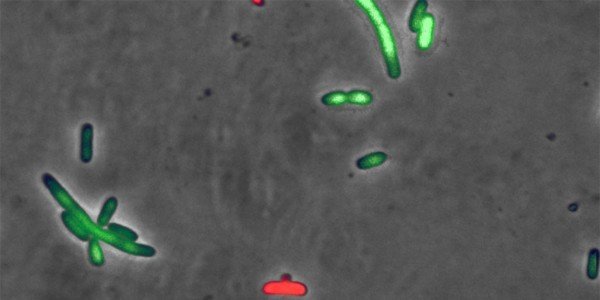
Programmed Bacterial Cell Death
The zeta toxins are a family of proteins that are normally present within various pathogenic bacteria that can mysteriously trigger their suicide.
The killer within - a novel bacterial suicide mechanism

Recently, we were able to unravel the mechanism underlying this programmed bacterial cell death. and showed that zeta toxins convert a compound required for bacterial cell wall synthesis into a poison that kills bacteria from within. In the future it may be possible to hijack this mechanism for bacterial defense and to design drugs that mimic these toxins.
Most bacteria harbor toxin-antitoxin (TA) systems, in which a bacterial toxin lies dormant under normal conditions, prevented from being active by its antitoxin counterpart. As long as the antitoxin is present, the bacterium can continue to exist and is not affected by the TA system. Under conditions of stress, however, the antitoxin is degraded, freeing the toxin to attack its host from within. Although the family of zeta toxins was discovered almost 20 years ago, their deadly mechanism has been enigmatic until now.
We studied the molecular mechanism of action of the zeta toxin PezT from the PezAT (Pneumococcal epsilon zeta Antitoxin Toxin) system using the model bacterium Escherichia coli. The PezAT system is found in the major human pathogen Streptococcus pneumoniae – a bacterium that causes serious infections such as pneumonia, septicaemia and meningitis. Bacterial cells in which PezT was activated showed symptoms of poisoning similar to the effects of penicillin. This involved first stalling in the middle of their division stage, and later the intersection zone between the two cell bodies burst and the cells died. We found that PezT and other zeta toxins are novel enzymes that transform the essential sugar building block UNAG (UDP-N-acetylglucosamine) into a toxic molecule. This molecule (UNAG-3P) inhibits the growth of the bacterial cell wall, causing the cells to burst and die.
The findings might also explain a hitherto paradoxical phenomenon; namely, that the supposedly lethal activity of pneumococcal zeta toxin PezT can eventually boost the pneumococcal infection rate of the entire attacking cellular population. The activation of PezT actively causes individual bacteria to burst and release their cell contents. However, other individuals that are metabolically less active can survive the toxin’s activity to some extent. In this process, the accelerated release of bacterial venoms by a subpopulation supports the surviving cells in their attack on the immune system during infection. It therefore seems that individual pneumococci altruistically sacrifice themselves during infection for the good of the overall population.
![[""] original](/18436/original-1314788441.jpg?t=eyJ3aWR0aCI6MzQxLCJmaWxlX2V4dGVuc2lvbiI6ImpwZyIsIm9ial9pZCI6MTg0MzZ9--3ddbda6099dd9b911d13ebb1244444b9a3a43a01)